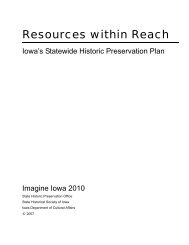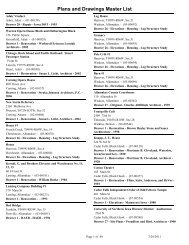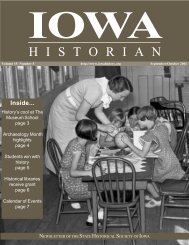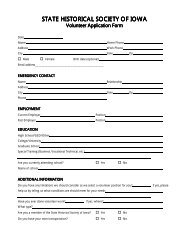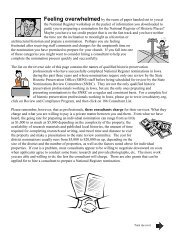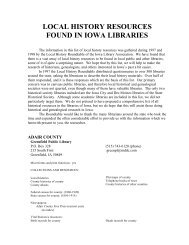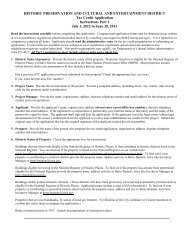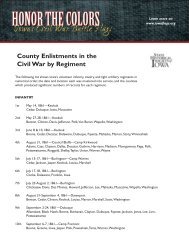Study of Flags - State Historical Society of Iowa
Study of Flags - State Historical Society of Iowa
Study of Flags - State Historical Society of Iowa
You also want an ePaper? Increase the reach of your titles
YUMPU automatically turns print PDFs into web optimized ePapers that Google loves.
The <strong>Study</strong> <strong>of</strong> <strong>Flags</strong><br />
Grade Level: 1, 4-5, 10-11<br />
Time Needed: Grade 1 – 1 class, otherwise 3-4 classes<br />
Goals/Objectives/Student Outcomes:<br />
Learn basic information on flags, their history and parts.<br />
Understand different kinds <strong>of</strong> flags and their various uses.<br />
Recognize some flags are important symbols.<br />
Understand the creation and meaning <strong>of</strong> the flag <strong>of</strong> the United <strong>State</strong>s and the flag <strong>of</strong> <strong>Iowa</strong>.<br />
Understand the significance <strong>of</strong> <strong>Iowa</strong>’s Civil War Battle <strong>Flags</strong><br />
Design and create a personal symbolic flag to display in the classroom.<br />
Identify a topic, identify resources, read, research and analyze information<br />
Work cooperatively with others in researching and presenting a flag topic.<br />
Develop and present a group oral report on their topic.<br />
Summarize and analyze their group presentation and participation.<br />
Materials:<br />
1. Posters <strong>of</strong> flags <strong>of</strong> the world, historical American flags, Civil War flags, pictures <strong>of</strong> different kinds <strong>of</strong> flags.<br />
2. Handouts from the <strong>State</strong> <strong>Historical</strong> <strong>Society</strong> <strong>of</strong> the parts <strong>of</strong> flags.<br />
3. Classroom flags <strong>of</strong> the United <strong>State</strong>s and the <strong>Iowa</strong> state flag.<br />
Background:<br />
The dictionary description <strong>of</strong> a flag is “a piece <strong>of</strong> cloth, usually rectangular, <strong>of</strong> distinctive color and design, used as a symbol, standard, signal or<br />
emblem.” A symbol is “something that represents something else.” A national flag symbolizes a country. A state flag symbolizes a state. <strong>Flags</strong><br />
can be powerful symbols. Think <strong>of</strong> the national flag draped over a c<strong>of</strong>fin or the feeling from seeing photographs <strong>of</strong> the flag raised on Mt.<br />
Suribachi in the Battle <strong>of</strong> <strong>Iowa</strong> Jima or the flags shown in memory <strong>of</strong> 9-11.<br />
The colors <strong>of</strong> the American flag are the same colors as in the British Union Jack. The Secretary <strong>of</strong> the Continental Congress, Charles Thomson<br />
said “White symbolizes purity and innocence; Red, hardiness and valour; and Blue, vigilance, perseverance and justice.”<br />
The number <strong>of</strong> stars represents the number <strong>of</strong> states in the Union. The red and white stripes represent the original 13 colonies. The Stars and<br />
Stripes became the <strong>of</strong>ficial flag on June 14, 1777.<br />
<strong>Iowa</strong> did not adopt a state flag until 1921. <strong>Iowa</strong> National Guard regiments stationed in World War I and along the Mexican border requested one<br />
to designate their units. The state’s Daughter’s <strong>of</strong> the American Revolution (DAR) decided to create a banner and a winning design was submitted
y Dixie Cornell Gebhardt <strong>of</strong> Knoxville in 1917. She explained the blue stripe stood for loyalty, justice and truth; the white for purity; and the red<br />
for courage. On the white center stripe is an eagle carrying in its beak blue streamers with the state motto: “Our liberties we prize and our rights<br />
we will maintain.” The state name IOWA is printed in red letters below the eagle. When displayed with the U.S. flag, state flags must be flown<br />
below the national one.<br />
There are many other kinds <strong>of</strong> flags besides the national symbols. Many cities have flags. Organizations like the Olympics, the Red Cross, the Girl<br />
Scouts and the Boy Scouts have flags. <strong>Flags</strong> are also used as messages like a red flag for danger, a white flag for surrender or even a pirate flag <strong>of</strong><br />
warning. There is an International Code <strong>of</strong> flags used for signaling. Each flag represents a letter in the alphabet with a different colorful design.<br />
<strong>Flags</strong> are also used for decorations at celebrations or memorials.<br />
<strong>Flags</strong> have been used for over 4000 years. The study <strong>of</strong> flags is called “vexillology” from the Latin word “vexilloids” which means “guide.” The<br />
first vexilloids were poles with carved tops used to guide soldiers. Fabric was added to the poles around 2000 years ago. Pieces <strong>of</strong> woven fabric<br />
were sewn together and decorated with paint or embroidery. Different colors and designs had meanings. Heraldry developed from these designs to<br />
help knights and foot soldiers distinguish friend from enemy in the confusion <strong>of</strong> battle. Soldiers looked for their various flags in a battle to be able<br />
to tell how the fight was going and where their fellow soldiers were located. <strong>Flags</strong> directed the movements <strong>of</strong> the soldiers and identified their<br />
group to leaders in the distance.<br />
Over time, military units were represented by their own flags. They meant more to the soldiers than simple guides. Since the establishment <strong>of</strong> the<br />
United <strong>State</strong> Army in 1785, the US regular infantry regiments carried their own colors or flags. They did not carry the national flag since it was<br />
felt that no one unit should carry the national honor into battle. The colors gave them a group identity. The soldiers felt the flags represented their<br />
honor and pride. They were <strong>of</strong>ten made by home towns and women in the community and given with great ceremony as gifts to the units, so they<br />
also symbolized home and family. During the Civil War, a soldier was honored for saving his unit’s colors or for capturing enemy colors. If a flag<br />
was lost in battle, so were the regiment’s position, identity and honor. By the 1840s, the national flag was carried by the infantry with the<br />
regimental number or title printed on one <strong>of</strong> the white stripes. If the flag was lost, only the regiment’s honor was lost and not the national honor.<br />
When a regiment fought with great bravery and distinction at a battle, they were allowed to have the name <strong>of</strong> the battle painted directly on their<br />
flag. Battle honors made the flags even more important.<br />
In 1894, the Adjutant General called for the flags <strong>of</strong> <strong>Iowa</strong>’s Civil War regiments to be marched to the <strong>State</strong> Capitol and enclosed in exhibit cases<br />
by the legislative chambers. They were moved temporarily during a 1904 fire in the Capitol and placed in rotunda cases on the first floor in 1905.<br />
Spanish-American and World War I flags joined them later. These rare artifacts represent the service and sacrifice <strong>of</strong> thousands <strong>of</strong> <strong>Iowa</strong>ns. They<br />
are endangered by years <strong>of</strong> display and neglect. Sunlight, smoke and heavy gauze used to support each flag has caused damage, some <strong>of</strong> it severe,<br />
if left unchecked, the damage eventually would have become greater than what the flags suffered in battle. In the 1990s, civic groups including the<br />
Sons <strong>of</strong> Union Veterans encouraged the state to provide conservation care to these flags. After a study directed by the Legislature, and support<br />
from the General Assembly and the Governor’s <strong>of</strong>fice, the <strong>Iowa</strong> Battle Flag Project began in 2001. Nearly 217 Civil War <strong>Flags</strong> are in great need <strong>of</strong><br />
extensive conservation efforts to save and exhibit them for future generations. On average, it takes conservators up to 240 hours to preserve a flag,
and up to 4,000 stitches per side are individually and carefully cut by hand to remove the gauze. The average cost to stabilize a single flag is<br />
$4,800. The museum plans to rotate flags in and out <strong>of</strong> public exhibits as they are preserved and prepared for display.<br />
Procedure:<br />
Class #1 -<br />
Learn basic information on flags and the parts <strong>of</strong> flags.<br />
Discuss different kinds <strong>of</strong> flags and symbolism.<br />
Discuss and identify flag topics for future presentation.<br />
Create a personal flag to display in the classroom – this can be assigned homework.<br />
Class #2 (An extra class period can be set aside for research and preparation)<br />
Set up personal flags in a display around the classroom<br />
Decide which flag topics will be researched and form cooperative groups. Assign a future time for presentations. Set a time limit for<br />
presentations depending on the age <strong>of</strong> the students, the complexity <strong>of</strong> the topic and the number <strong>of</strong> students in a group. Review the elements<br />
<strong>of</strong> successful research and sources <strong>of</strong> information.<br />
Students should be aware <strong>of</strong> the different group’s topics and told to think <strong>of</strong> questions for each presentation.<br />
Students meet with their group to go over notes and decide on the format <strong>of</strong> their presentation and if it will include pictures or drawings.<br />
Research their subject, using the library and computers, reading, taking notes and outlining.<br />
Class #3<br />
Guests can be invited to hear presentations.<br />
Presentations are given followed by a brief question and answer time. Other students are encouraged to ask questions and have a brief<br />
discussion.<br />
After the presentations are finished, ask the class if they were surprised by any <strong>of</strong> the information and were interested in learning more<br />
about a certain topic.<br />
Each group hands in a folder with their combined study notes, outlines, presentation notes and a review <strong>of</strong> their project and presentation.<br />
They could meet with their teacher to go over this material or the teacher could examine it privately.<br />
Assessment <strong>of</strong> outcomes:<br />
Contributions to class discussion and asking questions.<br />
Cooperation/teamwork skills<br />
Research, writing and oral presentation skills
Amount <strong>of</strong> participation in projects and creativity.<br />
Completion <strong>of</strong> cooperative group assignment.<br />
Extensions and Adaptations:<br />
Most <strong>of</strong> the activities listed under procedures can be adapted to meet the learning needs <strong>of</strong> most students at various ages. Personal flags can be<br />
designed to represent themselves, their family, their class or their school. Research and projects could focus on flags connected to the development<br />
<strong>of</strong> the United <strong>State</strong>s from colonial and Revolutionary War flags to the first national flag. Many countries claimed parts <strong>of</strong> North America. A<br />
project could include the different flags that have flown over North America. Other projects could focus on the Star Spangled Banner, facts about<br />
the national flag, state flag, flags <strong>of</strong> different countries, or various kinds <strong>of</strong> flags. Copies <strong>of</strong> flags from around the world could be displayed to<br />
represent the ancestral backgrounds <strong>of</strong> students in the class. Each flag has a specific meaning and a unique history. A project could explain the<br />
symbolism <strong>of</strong> colors, size, and design.<br />
Students studying the Civil War would prepare for a visit to the <strong>State</strong> <strong>Historical</strong> Building to see the exhibit and Battle <strong>Flags</strong>. <strong>Iowa</strong> regiments and<br />
their flags could be tracked to follow their service during the Civil War. A project could focus on Color Guards who were entrusted with the flags<br />
<strong>of</strong> the regiment. Other projects could include information on the different kinds <strong>of</strong> flags carried in the Civil War and Confederate flags. Older<br />
students (12 or older) working on a presentation on a particular flag or on preservation could arrange for a visit to the <strong>Iowa</strong> Battle Flag<br />
Preservation Lab to hear stories <strong>of</strong> the flags and view them up-close. The <strong>Iowa</strong> Battle Flag preservation video that discusses the history <strong>of</strong> the<br />
project and the significance <strong>of</strong> the flags could be shown in class. A project could focus on the history <strong>of</strong> the battle flags and the grass roots support<br />
for their care. The <strong>Iowa</strong> Battle Flag Preservation website is at http://www.iowaflags.org/ The National Museum <strong>of</strong> American History, Smithsonian<br />
Institution has a website section on the science <strong>of</strong> preservation and their special conservation laboratory built to accommodate the Star-Spangled<br />
Banner treatment.<br />
RESOURCES<br />
Elementary:<br />
Herman, John. Red, White, and Blue ( All Aboard Reading Level 2 ). Grosset & Dunlap, 1998.<br />
Kent, Deborah. The Star Spangled Banner. Chicago: Children’s Press, 1995.<br />
Lewison, Wendy Cheyette. F is for Flag ( Reading Railroad Books ). Grosset & Dunlap, 2002.<br />
Spier, Peter. The Star Spangled Banner ( Reading Rainbow Books ). Dragonfly Books, 1992.<br />
Secondary and Adult
Corcoran, Michael. For Which It Stands: An Anecdotal History <strong>of</strong> the American Flag.<br />
Simon & Schuster, 2002.<br />
Guenter, Scot M. The American Flag 1924-1977. New Jersey: Fairleigh Dickinson University Press, 1990.<br />
Katcher, Phillip. Confederate <strong>Flags</strong> <strong>of</strong> the Civil War ( Battle Ready Series ). Raintree Pub., 2003.<br />
Katcher, Phillip. Union <strong>Flags</strong> <strong>of</strong> the Civil War ( Battle Ready Series ). Raintree Pub., 2003.<br />
Adult:<br />
Bown, Deni. Ultimate Pocket <strong>Flags</strong> <strong>of</strong> the World. Dorling Kindersley, November,1997.<br />
Cannon Jr., Devereaux. The <strong>Flags</strong> <strong>of</strong> the Confederacy, An Illustrated History. Pelican Pub. Co., October, 1994.<br />
Cannon Jr., Devereaux and Pardue, Larry (Illustrator). The <strong>Flags</strong> <strong>of</strong> the Union, An Illustrated History. Pelican Pub.Co., May 1994.<br />
Devereaux, Eve. Identifying <strong>Flags</strong>, The New Compact <strong>Study</strong> Guide and Identifier. Book Sales, 1998.<br />
Eyewitness Handbooks: <strong>Flags</strong>. Dorling Kindersley, June, 1999.<br />
Znamierowski, Alfred. <strong>Flags</strong> Through the Ages, A Guide to the World <strong>of</strong> <strong>Flags</strong>, Banners, Standards and Ensigns. Lorenz Books, September,<br />
2000.<br />
Znamierowski, Alfred. The World Encyclopedia <strong>of</strong> <strong>Flags</strong>, The Definitive Guide to International <strong>Flags</strong>, Banners, Standards, and Ensigns.<br />
Lorenz Books, December, 1999.<br />
This lesson plan may be used to meet the following academic standards:<br />
National History Standards<br />
Topic 3 - The History <strong>of</strong> the United <strong>State</strong>s: Democratic Principles and Values and the Cultures Who Contributed to its Cultural,<br />
Economic and Political Heritage.<br />
1. Understands how democratic values came to be and how they have been exemplified by events and symbols.<br />
National Council for Social Studies Curriculum Standards
Theme II: Time, Continuity and Change<br />
Human beings seek to understand their historic roots and to locate themselves in time. Such understanding involves knowing what things were like<br />
in the past and how things change and develop – allowing us to develop historic perspectives and answer important questions about our current<br />
condition.<br />
Des Moines Public Schools Standards<br />
Art<br />
Grade 1: Design. Drawing.<br />
Grades 4 & 5: Appreciation. Design. Drawing.<br />
Language Arts<br />
Grades 4 th & 5 th : Writing. <strong>Study</strong> Skills<br />
Reading<br />
Grade 4: Writes a summary.<br />
Grade 5: Writes a summary. Is able to draw conclusions.<br />
Social Studies<br />
Grade 1: Recognize important symbols <strong>of</strong> American Democracy<br />
Grade 4: Researches and presents an oral report. Locates and uses appropriate information.<br />
Grade 5: Recognizes trends in the growth and development <strong>of</strong> the United <strong>State</strong>s.<br />
Social Skills: Working in a group.<br />
Thinking Skills: Analyze, compare and contrast, make decisions, acquire and use research and library skills.<br />
Secondary Grades<br />
U.S. History, Grades 10-11<br />
Era 3 - Revolution and the New Nation, Std. 3<br />
Era 5 - Civil War and Reconstruction, Std. 2<br />
Flag Conservation and Preservation, Scientific Inquiry<br />
Interactive Science, Chemistry, Grades 9-11<br />
The nature <strong>of</strong> matter and its relationship to chemical changes.
Canton<br />
Battle honors<br />
Pole sleeve<br />
Hoist end<br />
7 red stripes<br />
6 white stripes<br />
Fly End<br />
6 feet<br />
(2 ft. 3 in Cavalry)<br />
Fringe<br />
6 ½ feet<br />
((2 ft. 5 in Cavalry)<br />
1859 Oregon 33 rd <strong>State</strong> 1861 Kansas 34 th <strong>State</strong> 1863 West Virginia 35 th <strong>State</strong> 1864 Nevada 36 th <strong>State</strong> 1867 Nebraska 37 th <strong>State</strong>
Hoist end<br />
Pole Sleeve Battle Honors Fly End<br />
Arch <strong>of</strong> Stars<br />
Design<br />
Coat <strong>of</strong> arms <strong>of</strong> the United (I & C)<br />
Crossed Cannons (A)<br />
6 feet<br />
(2 ft. 3 in Cavalry)<br />
Regimental Ribbon<br />
6 ½ feet<br />
(2 ft. 5 in Cavalry)<br />
Fringe





